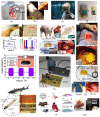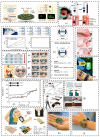Survey on Energy Harvesting for Biomedical Devices: Applications, Challenges and Future Prospects for African Countries
- PMID: 38203025
- PMCID: PMC11326079
- DOI: 10.3390/s24010163
Survey on Energy Harvesting for Biomedical Devices: Applications, Challenges and Future Prospects for African Countries
Abstract
Self-powered biomedical devices, which are the new vision of Internet Of Things (IOT) healthcare, are facing many technical and application challenges. Many research works have reported biomedical devices and self-powered applications for healthcare, along with various strategies to improve the monitoring time of self-powered devices or to eliminate the dependence on electrochemical batteries. However, none of these works have especially assessed the development and application of healthcare devices in an African context. This article provides a comprehensive review of self-powered devices in the biomedical research field, introduces their applications for healthcare, evaluates their status in Africa by providing a thorough review of existing biomedical device initiatives and available financial and scientific cooperation institutions in Africa for the biomedical research field, and highlights general challenges for implementing self-powered biomedical devices and particular challenges related to developing countries. The future perspectives of the aforementioned research field are provided, as well as an architecture for improving this research field in developing countries.
Keywords: Africa; biomedical research; biomedical research funding; energy harvesting; self-powered biomedical devices.
Conflict of interest statement
The authors declare no conflicts of interest. The funders had no role in the design of the study; in the collection, analyses, or interpretation of data; in the writing of the manuscript; or in the decision to publish the results.
Figures






Similar articles
-
Self-Sustainable Biomedical Devices Powered by RF Energy: A Review.Sensors (Basel). 2022 Aug 24;22(17):6371. doi: 10.3390/s22176371. Sensors (Basel). 2022. PMID: 36080825 Free PMC article. Review.
-
Self-powered technology based on nanogenerators for biomedical applications.Exploration (Beijing). 2021 Sep 1;1(1):90-114. doi: 10.1002/EXP.20210152. eCollection 2021 Aug. Exploration (Beijing). 2021. PMID: 37366464 Free PMC article. Review.
-
Application, challenge and perspective of triboelectric nanogenerator as micro-nano energy and self-powered biosystem.Biosens Bioelectron. 2022 Nov 15;216:114595. doi: 10.1016/j.bios.2022.114595. Epub 2022 Jul 31. Biosens Bioelectron. 2022. PMID: 35973278 Review.
-
Piezoelectric Energy Harvesting towards Self-Powered Internet of Things (IoT) Sensors in Smart Cities.Sensors (Basel). 2021 Dec 13;21(24):8332. doi: 10.3390/s21248332. Sensors (Basel). 2021. PMID: 34960426 Free PMC article. Review.
-
Self-powered biomedical devices: biology, materials, and their interfaces.Prog Biomed Eng (Bristol). 2025 Feb 17;7(2). doi: 10.1088/2516-1091/adaff2. Prog Biomed Eng (Bristol). 2025. PMID: 39879660 Review.
References
-
- Global Data Fitness Watches May Soon Be Able to Monitor much More Than Weight and Heart Health, as Global Data Identifies 160 Ongoing Clinical Trials for Medical Wearables. [(accessed on 6 July 2023)]. Available online: https://www.globaldata.com/media/medical-devices/fitness-watches-may-soo...
-
- Cambridge University & Press Assessment Self-Powered. 2023. [(accessed on 8 July 2023)]. Available online: https://dictionary.cambridge.org/us/dictionary/english/self-powered.
-
- Force Technology ASIC Power Management for Self-Powered IoT Sensors. [(accessed on 8 July 2023)]. Available online: https://forcetechnology.com/en/articles/asic-power-management-self-power....
-
- Owens B.B., Salkind A.J. Key Events in the Evolution of Implantable Pacemaker Batteries. In: Owens B.B., editor. Batteries for Implantable Biomedical Devices. Springer; Boston, MA, USA: 1986. - DOI
-
- Barnhart P.W., Fischell R.E., Lewis K.B., Radford W.E. A fixed-rate rechargeable cardiac pacemaker. Appl. Phys. Lab. Techn. Dig. 1970;9:2.
Publication types
MeSH terms
Grants and funding
LinkOut - more resources
Full Text Sources

